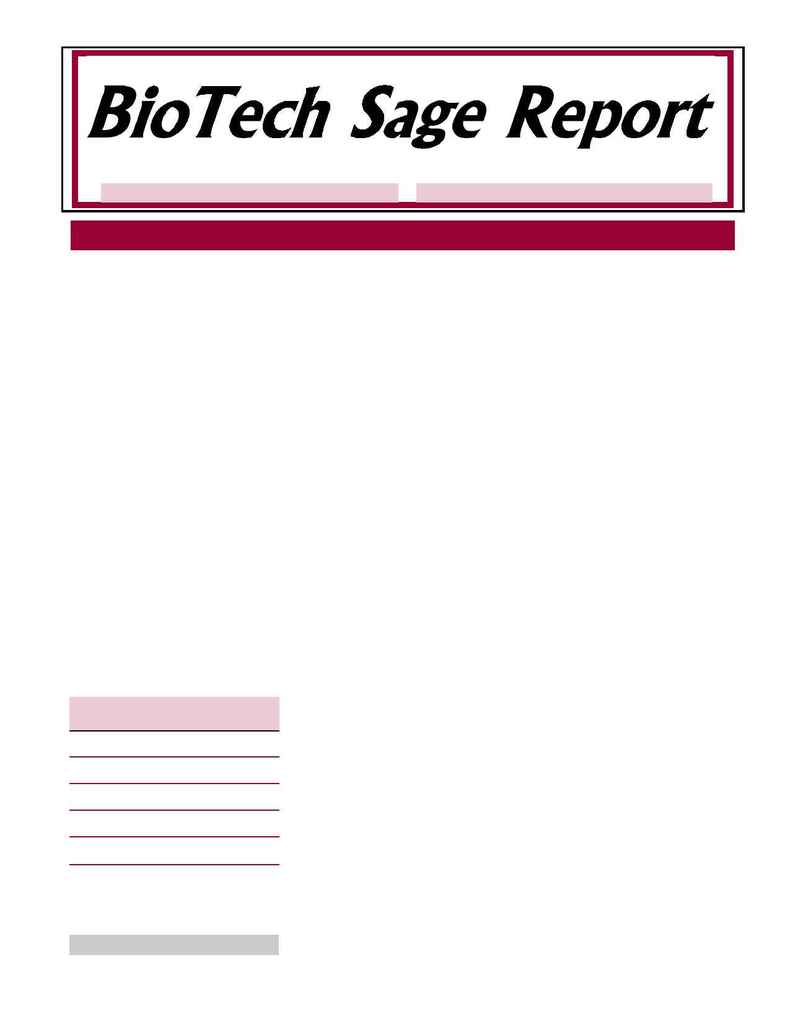
1
The investment report that gives you the essentials to wisely invest in biotechnology securities.
The investment report that gives you the essentials to wisely invest in biotechnology securities.
Volume 4, Issue 11
January 2001
To order, call (503) 649-1355
Bandages and Stitches
More Advanced than
Bandages and Stitches:
Interest in biotechnology compa-
nies led us to buy Amgen, Genentech,
Affymetrix and Millennium for their
growth and technological advance-
ment. Another biotech industry with
truly awesome potential is tissue engi-
neering or wound healing. It's not a
field where companies are just doing
basic research; instead there are some
that even have real-live products gen-
erating actual revenues on bandages
or stitches. Bandages or stitches will
mend wounds. But for some individu-
als these simple remedies don't cut it,
and when wounds don't heal, there is
an increase in discomfort that signifi-
cantly interferes with the individual's
quality of life. This often leads to
long-term disability and an increase in
the risk for development of additional
medical problems. Deterioration in
general health and well-being fre-
quently occurs, and physical and emo-
tional survival is often threatened.
So what types of wounds are be-
ing focused on and what patient popu-
lations are at risk? Unfortunately, the
population most at risk are those indi-
viduals who have a diminished capac-
ity to heal quickly, that being older
patients and people with chronic dis-
eases such as diabetes. These indi-
viduals often develop wounds or ul-
cers on their lower extremities that are
difficult to treat due to poor blood
circulation and cells that are less
likely to proliferate and have shorter
life spans. In addition, cells from
older patients are less responsive to
cytokines and growth factors that fa-
cilitate wound healing.
Bio Analysis
1-7
Bio Pool Stocks
8-9
Company Bio
10-12
BioTech Stock Update
13-16
Bio Portfolio
17
Bio Indices
Next Issue:
BSR #47 Super Bugs
18
BioScope
With the average age of Ameri-
cans increasing, it's easy to see that
the incidence of chronic skin wounds
is growing. In the United States (U.
S.) alone, the number of patients that
can be classified as vulnerable is ap-
proximately 2.5 million. This includes
those patients with diabetic foot ul-
cers (300,000-400,000), venous ul-
cers (700,000) and pressure sores
(over 1.5 million). The economics
associated with these conditions pres-
ents a significant commercial oppor-
tunity. For example, diabetics are
prone to foot ulcerations due to both
neurologic and vascular complica-
tions. Standard care for diabetic foot
ulcers may not heal wounds fast
enough to avoid life-threatening infec-
tion, necessitating amputation. Foot
ulcers are a leading cause of hospitali-
zation among diabetics and are esti-
mated to cost the U.S. health care sys-
tem over $1 billion annually.
Traditionally, there have been
two approaches to skin ulcer treat-
ment. The most common treatment for
